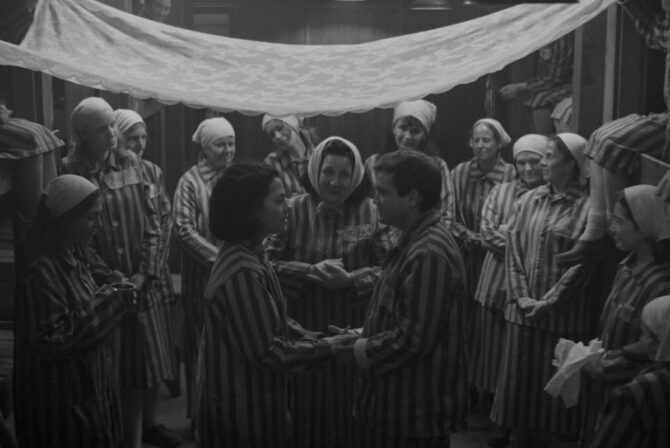It is a testament to my grief that I actually miss my mother’s bad cooking. My mom was an infamous eater and a lover of food. She scouted out of all the good dumpling and dim sum joints in Silicon Valley but could barely scramble an egg.
Her lack of skills in the kitchen was a source of pride for her, a feminist twist on the myth of the Jewish mother, of pushing food on people already so full that they must sneak away from the table in pain, bursting with kreplach.
Yes, Mom hated the idea of a loved one ever going hungry. But she didn’t think it was her duty to work in the kitchen to satisfy us — not when she had a credit card and there were fabulous restaurants a half block away.
As I grew up and started my own family, she seemed to get a degree of amusement of over how much time I was willing to spend cooking. Didn’t women of Mom’s generation endure the 70s — the decade of unsupported breasts and patterned mumus — to give women a break from these duties?
In the last few years of her life, Mom moved into an independent living facility with no oven. It was no great loss, except it meant that she couldn’t cook the one dish she’d mastered in her seven decades: a noodle kugel.
Mom pronounced the dish ku-gull, which means “ball” in Yiddish. I don’t think any food word has ever been more misleading. Then again, the evidence suggests that kugel, as we know it today, once meant “bread dumpling.’’ Over time, dumplings, which had spread from China to Europe by the 12th century , evolved into a series of starchy, eggy dishes, some of them sweet, some of them savory. According to the Joy of Kosher, the kind of kugel that my mother made dates back to roughly the 1600s, when European Jewish emigrants to Israel brought with them some enticing recipes for toothsome noodle-based kugels with a “caramelized” coating. To this day, kugel is one of the most sought-after Sabbath delicacies on the Jewish table.
Most Jewish families have their own proprietary kugel recipes that are guarded behind a shield of secrecy and duplicity. If a woman from shul called Mom to ask her the kugel recipe she’d respond gracefully and give it to them — but she’d conveniently leave out an ingredient or instruction.
“I think I forgot to tell her to add butter to the noodles,” Mom said, after hanging up. “Oh, well, what can you do?” Word must have spread about her carelessness with cooking instructions, because the inquiries dwindled and eventually stopped.
Mom would make the kugel with her grandchildren or for family celebrations. In the last month of my pregnancy, she would bake it and arrange for my husband to pick it up so that it was ready in my freezer, wrapped tidily in aluminum foil, if I ever had a craving. I usually gobbled it in a single evening.
The kugel was her signature dish until she moved to her oven-less apartment. But when she got sick last year, she declined very quickly. Getting her affairs in order was a matter of urgency, and there wasn’t a lot of time for anything else, least of all a recipe exchange.
It was exactly four months from her diagnosis of Acute Myeloid Leukemia to her funeral. I was still in shock when I packed up her apartment and moved most of her things into my frantically cleared-out garage.
A few weeks after her death in February, I wanted to make Mom’s kugel. I worried that I wouldn’t be able to duplicate her perfect version: light brown on its crispy top, and the color of milky coffee in the middle. It held its form amazingly well – you’d cut it with a sharp knife and the edge would leave a perfectly flat cross section of tangled noodles. Mom wasn’t here to call if I stumbled during the process. It was another reminder that I had to try and figure things out on my own.
And yet my grief was weighing on me so much that I had no choice but re-create her best dish. Mom had told me she’d trustingly left the recipe in the hands of my 9-year-old daughter, Julianna. I asked Julianna if she remembered how to make the kugel, and she nodded with enthusiasm.
“It’s easy, “ she said. “It’s only got eight ingredients.”
She began listing them: “Milk, sour cream, eggs, noodles, cornflakes, cream cheese, sugar.”
“There’s no cream cheese, it’s cottage cheese. And that’s only seven ingredients,” I said.
What was the missing ingredient? What were the ratios? And how did the whole thing go together? Even worse, how could my mom have left her one culinary triumph in the hands of a 9-year-old girl? Just like Mom, I wanted to make her signature dish for family celebrations and holidays — and I was planning to honor her memory by making it this Mother’s Day, my first without her. But how could I do that if the recipe was lost?
Then I started to dig through the boxes in my garage until I found mom’s recipe box. It was an old cornflower-blue Corning Ware Recipe File that originally housed 44 recipes for an Electromatic Self-Timing Saucepan. It was bulging and tied with a rubber band.
While I found the recipe for the heavy, flavorless Passover Potato Kugel (aka the 11th Plague of Passover), I couldn’t find the noodle kugel recipe anywhere.
Then, I remembered all the emails I had from my mom. They sat in my inbox, undeleted from 2007, and were a comforting guide — almost a conversation — that I turned to when I needed advice from Mom.
After a quick search, I found the kugel recipe. It came with a few instructions including the following: “You can substitute different kinds of cottage cheese — the biggie is not to rinse the noodles!”
I showed the email to Julianna. “There are 10 ingredients, not eight,” I said.
Julianna shrugged, unsurprised that my mom had given her the wrong information. And then we started to cook. I boiled the noodles and Julianna melted the butter. She mixed together the sour cream and cottage cheese in a large bowl. Then she added the sugar and milk. I added the buttered, unrinsed noodles, and vanilla.
Since I couldn’t find the cinnamon we decided to skip it. It seemed like a tribute to my mom to improvise a bit, especially if it meant skipping a trip to the grocery store.
We added the eggs last and I poured the mixture into a rectangular baking dish. Julianna sprinkled the cornflakes on the top.
“Is it suppose to go in covered, or uncovered?” I asked. Julianna didn’t know. Mom’s recipe, of course, left it open to interpretation.
I resisted the urge to pick up the phone and call the number that was no longer in service. I covered the kugel with tinfoil and put it in the oven.
After about 1 hour and 15 minutes the kugel was done and set it on the counter to cool. I like my kugel after its set in the fridge overnight, but Julianna couldn’t wait. She ate the first piece while it was only half-cool in front of the TV.
I waited until it cooled a bit more before I sampled. I missed the taste of the cinnamon, but despite the missing ingredient, we ate the Kugel in a day and a half. We cut off large pieces, gobbling them in a few bites, traveling back to the fridge and cutting off more, sometimes not bothering with a plate. We ate it for breakfast and after dinner. The hunger, the grief, the brief moment of satisfaction combined with the richness of the cheese left me a little giddy.
And of course, there was something missing, as I knew there would be. I was starting to get used to the feeling — a nagging sense of something you remember and savor but can never truly replace.
Mom’s Noodle Kugel
Ingredients:
1/2 lb. fine noodles
1/2 stick melted butter
1lb. creamed small curd cottage cheese
1/2 pint sour cream
1/2 cup milk
2/3 to 3/4 cup sugar mixed with 1 teaspoon cinnamon
3 eggs
1 tsp. vanilla
crushed cornflakes
Directions:
Preheat oven to 375 degrees
Cook noodles – DO NOT RINSE
Add melted butter
Mix in everything else (except cornflakes)
Grease dish with hot oil or butter, pour in mixture
Cover with crushed corn flakes
Bake for 1 and 1/4 hours







